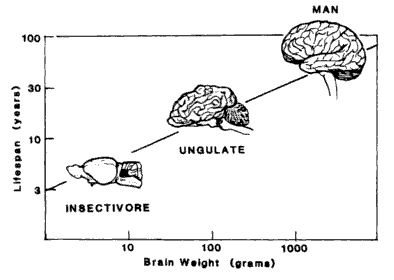Invariant Ratio of Lifespan
There are very few rules that seem to apply to biology across the board. One rule of thumb that applies to the animal kingdom is that the lifespan of an animal is proportional to its size. Small animals have short lives, big animals longer ones. A tiny mouse has a maximum life of about 3 years while an elephant could live to 70. This ratio of longevity to body mass is fairly fixed across species: one paper expresses the ratio as ranging from 0.15 to 0.3. According to one calculation for every 10% larger an animal is, it lives 6% longer. This can be illustrated with a graph of maximum lifespan vs. brain size (itself related to body mass), as shown in this diagram from Hormones and Aging.

Since small animals have higher heart rates than large ones there has long been a suspicion that all animals live out the same number of heart beats. Or to put it another way, all hearts contain the same number of beats. The mythological magic number of total heart beats is one billion. By this measure when a mouse reached a billion heart beats after 3 years, it died, just as the elephant reached its one billion heart beats in 70 years. The actual data shows more variance. A small dog clocks in at .5 billion heart beats while a chicken gets 2 billion. However that is about the full range of heartbeats for most animals: between one half and two billion heartbeats.
Although total beats vary a little bit, the rate of metabolism in terms of energy spent per kilogram of body weight does show a closer invariance across animal species. J.R. Speakman states that “this means that across species a gram of tissue on average expends about the same amount of energy before it dies regardless of whether that tissue is located in a shrew, a cow, an elephant or a whale.”
Recently researchers have found a similar and surprising invariance in the ration of lifespan vs mass in plants. Writing in the Proceedings of the National Academy of Sciences as reported by New Scientist, Núria Marbà at the University of the Balearic Islands in Palma, Majorca, Spain found that “in a stable plant community, reproduction rates and death rates of plant species were related to the mass of the fully grown plant raised to the power of minus one-quarter: big plants were slower both to die and to reproduce than small ones.” And it appears that this ratio “applies across the plant kingdom, from seagrass to ferns and redwoods.”
Boldly going where no sane person would tread, I propose that this ratio is probably also true for all vivisystems (life-like systems) such as the internet and eventually robots. Manufactured vivisystems may have a fixed number of energetic cycles. Larger-scale systems, like the global web, have a slow refresh cycle, taking a day or hours to crawl the entire websphere. The internet may live longer (before it crashes) compared to the short intense lives of a robot, or laptop of the future. Yet both species of technology may count the same number of total lifetime “cycle beats.”


